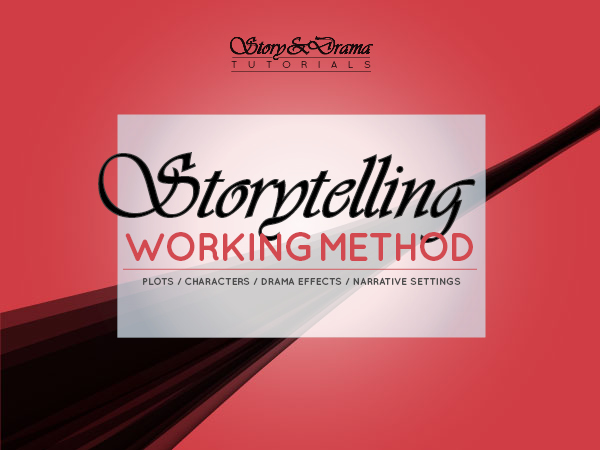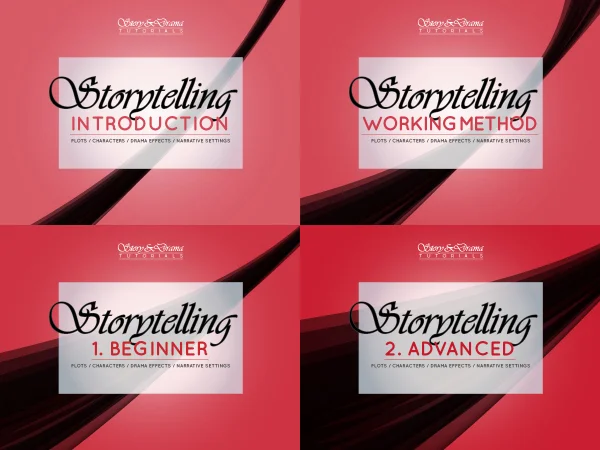 |
|
|
PDF, 42 pages
|
Free!
|
| Read the Free storytelling working method | |
This page is an abstract from our Storytelling Working Method PDF.
Summary
- Presentation + download free PDF
- Part 1.1. Steps of work and working documents
- Part 1.2. Story Project setup
- Part 1.3. Story development
- Part 2. Brainstorm and research
- Part 3. How to write plots and characters
- Part 4. Writing the final script
- Part 5. Sending or making
Part 3. How to write plots and characters
The first idea
The first idea might be one that everybody can have: then, everybody will find it poor, too usual, valueless. The audience prefers what is smarter, unique, unseen, striking and fascinating.
To help building better ideas and organize them, we can use tools, softwares, databases, heuristic maps… We make the point about this technical side of storytelling in Story&Drama 2.Advanced.
From the selected genres and reference-works, we abstract typical patterns of plots, characters, properties, that we could adapt to our project.
If our plan is to write a Jewish Godfather, then isolate what is typical in this movie – ex, the struggle in a family for succession? the struggle of a clan against its enemies? – and use it as a base to build our own story.
Do we want to write a story of gangsters? Then let’s analyze 5-10 of the most famous ones, find the main lines, abstract the values systems, the archetypes, the conflicts. We can then re-use what we found, mix it, melt it, re-cut it, marry it with opposite elements, subvert it, transpose it…
From the list of messages and impacts that we defined during the setup step, we translate them into plots that mean the same than those messages and have the impacts we want.
We are writing a stand-up comedy sketch that will last 10 minutes. we want to make people laugh very frequently, like every 10 seconds in average. This impact will be obtained through the structure.
We want to write a really provocative show, so we make a little list of the most shocking and forbidden themes, and we have fun mixing them together to obtain something even more horrible. That provides us some new plots, situations and characters that match our first intentions.
We get ready to design a general structure of the final work.
From our setup and our research, we now have a much better idea about what our final work should look like. We gathered a big quantity of materials.
We now need to decide what to keep and how to use it.
This step may lead us backwards to the brainstorm and research step: we might need to get more documentation about a precise topic when we decided to use it as an element of our script.
Design the pitch
The pitch, also known as high concept, is a sentence or a short paragraph that describes the story’s main idea and can be seen as the shortest expression of the quality of a story. It has to be… interesting, catchy, mysterious, meaningful, challenging, entertaining, or other major qualities.
It does not belong to the final script, but it may be transmitted to our working partners and to decision-makers to know whether or not they are interested in supporting our project of story. It can also be used to promote the story in the media once it has been turned into a full artwork.
Writing a pitch is a decisive exercise to force us to center the story soundly around one strong axis.
Here are a few remarkable pitches from famous artworks:
- “A young man has to become a mafia leader to protect his father” (THE GODFATHER)
- “A man has fun scaring his girlfriend in a series of horror plots” (THRILLER)
- “Satan takes control over Moscow” (THE MASTER AND MARGUERITE, novel by Mikhaïl Bulgakov),
- “An unsuccessful male actor becomes a successful feminist actress” (TOOTSIE),
- “An extra-terrestrial lost on earth wants to go home” (E.T.),
- “How Mr. Milk became the first gay Mayor” (MILK), etc.
Design a plots structure
To obtain the plots structure, we can start from any side of it: by developing the plots, or the plots structure, or the characters, or the sets of characters, as well.
Indeed, everything is complementary, one choice here has a consequence there. If we create a character, we necessarily involve it in a plot, and vice-versa.
We can develop a plot from a Hero and a structure from this plot, then give it a side plot and give it a set of characters.
We can start from one event, then build a plot around it, and elaborate its set of characters later on.
Detail each plot with its plot points, dramatic turns, processes, info revelations…
Once we have a general outline of the plots structure, we have to develop each of our plots a more detailed way. We can do so by writing a quick sum up of those plots.
Use one sentence or one short paragraph by plot point, not more!
Build the sets of characters
Build the sets of characters of each plot from their Hero, give the Hero an Antagonist, give them Mentors, Skeptics and Helpers (if needed!)
Build each character’s set of properties of each character of each plot – generally in this order: Hero, Antagonist, then members of their teams
Balance the dramatic properties together
Design sets of values and attribute them to sets of characters.
Project 1 – Heroic fantasy novel
Pitch: “A very empathetic and intuitive Ambassador sent to declare war actually works for peace, betrays his side and prevents a generalized war between 5 civilizations”.
Isolated but smart, he has the special ability to travel through a magic door. He will have to oppose and calm down all the conflicts in the societies he crosses.
Some major plots tell the enterprises of warriors and conflict-makers – the Antagonists of our Hero. Some minor plots explore sides of life in Europe, China and Mali: a rural family in Europe, the women of a monastery in China, and a poet in the court of the Emperor of Mali.
We develop all our plots and characters in detailed schemes. We then arrange them in a general outline.
Project 2 – Electroclash album
Pitch: We could define the album as “a chronicle of modern life from the point of view of a 17yo rebellious girl who makes fun of authorities, declares war to sexism, claims freedom and hedonism, and fights for love…”
We select themes and concepts to design the world of this girl. We create characters around her – her best friend, ex-boyfriends, school, family and city…
Then we build song sketches around short, explosive plots. For some, we start from a few lines we had the intuition of; for some others, we start from a joke, an ambiance, a memory, a famous quote… We also link those plots, events and characters to other plots, events, characters, so as to obtain a coherent overall story.
Project 3 – Hip-hop photonovel
The pitch could be: a 30 black blind rapper witnesses his life experiences from hiw watch with the eyes of the soul. He sees beyond the surface, beyond the standards, and converts the experience of violence and misery into something aesthetic and nearly mystic.
We design the core of the plots to build: a series of everyday life events that, accumulated, will describe the dramas and beauty from the ghetto. We firstly build main lines, that we style later on with more details. We obtain a collection of mini-stories sketches.
Project 4 – The Squatt
The pitch would be something like: 20 young people living in a Berlin community have 20 different ways to revolution the world – or at least, their little world.
In this story, the characters are very important, so we start by dealing with them. We sketch a theme structure for those 20 core characters. We give each of them a different identity: job, skills, hobbies, passions, past traumas, existential goals, future problems. Some are best friends or lovers, and some are enemies. We try to balance them so that they can represent the best and the worst of our society.
Special offer – 4 scenario tutorials for only $30
Story&Drama offers you 4 scenario tutorials for $30.
Download them all immediately!
 |
|
4 PDF
|